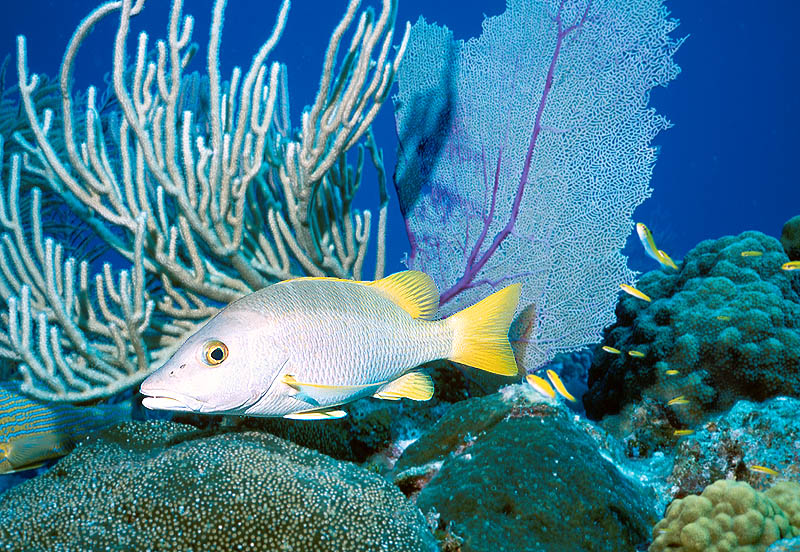
Volume 5 Number 7
Schoolmaster at Coral Gardens Reef
near Grand Turk


Volume 5 Number 7
Schoolmaster at Coral Gardens Reef
near Grand Turk

The reef named Coral Gardens just west of Grand Turk has some of the healthiest corals in North America. The coral colonies are thick, and the colonies are covered almost completely by healthy coral polyps.
This picture features a Schoolmaster, a common species from a family of fishes called Snappers. This Schoolmaster was about 14 inches long.
What is it like to dive with a Schoolmaster? Well, first you jump into the water from a boat near the reef. After getting your gear under control (that is, making sure your air tank is turned on, your camera is turned on, your spare regulator is attached to your vest the way you want it, and so on), you begin your descent to the reef. You let all the air out of your gear so you won't float, then you point your head toward the bottom and begin to swim down to the reef. You swim to the reef slowly to help keep your ears clear. The deeper you go, the more the pressure of the water increases against your ears. So, every few feet, you have to clear your ears. Eventually, you work your way down to the reef, and begin to swim along the edge of the reef to look at the corals. Almost every dive you will come to a crevice or a canyon containing a school of Schoolmasters. These fish will just look at you, and as long as you don't move toward them too fast they will let you swim pretty close to them. If you get too close or approach too fast, the Schoolmasters will turn tail and swim away.
Schoolmasters are identified by their beautiful yellow fins and tails. Their bodies are silvery-white, which makes them hard to photograph. Their bodies are so shiny that the flash from the camera strobe can overexpose the film rather easily. Notice the pattern of gray outlines on the scales on the sides of this Schoolmaster.
You probably noticed all the tiny yellow fish near the right side of this picture. These fish are some kind of Wrasse, probably juvenile Blueheaded Wrasse identified by the tiny black spot on their dorsal fins. As they get older, they will change color, winding up with bright blue heads in their most-advanced adult color phase.
And if you have sharp eyes, you also noticed the side of a Blue-Striped Grunt at the lower left corner of this picture. Its head is out of the picture, and its tail was behind the tall Sea Rod Coral, but its blue stripes and yellow body are easily identified. Click here for to see another picture showing Blue-Striped Grunts.
Pay special attention to all of the healthy corals in this picture. Underneath the Schoolmaster are large mounds of Star Corals. And behind the Schoolmaster are towering colonies of Sea Rod and Sea Fan Corals. Each of these colonies is packed, with the entire surface of each colony covered by polyps. There are very few spots of dead corals anywhere in this picture.
ReefNews photographer Tessa Dowell took this photo using a Nikonos V camera with a 28 mm lens and a Nikon SB105 strobe. The photo was taken on June 24, 2002.
--------------------
e-ReefNews and embedded illustrations are
Copyright © 2002, 2003, ReefNews, Inc.
ReefNews ® is a registered trademark of ReefNews, Inc.